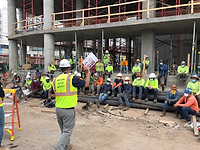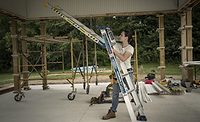Roof Safety: Managing Your Ladder

If you’re working on a roof, chances are you got there using a ladder. Falls are the leading cause of injuries and fatalities in the workplace and the statistics for the roofing industry are even worse than other trades. You can reduce your chances of being one of these statistics by following a few basic guidelines.
Choosing the Right Ladder
Workers should use stepladders in the open (A-frame) position and should never use the top step or top cap of the ladder. Even if a stepladder is tall enough, never use it to access a roof. If you are climbing onto a roof, use an extension ladder instead.
When choosing the right extension ladder, consider three categories: material, weight rating and length.
Material: The two main ladder materials are fiberglass and aluminum. Fiberglass has the advantage of being nonconductive if you are working around electricity. Aluminum is lighter and more durable for projects not involved with electricity. If you are using an aluminum ladder, make sure to check overhead for existing powerlines.
Weight Rating: Chances are, a ladder on a worksite will be used by everyone, so you should plan for the biggest person on your crew when choosing the ladder. Calculate the weight rating required by adding the user’s weight, his or her clothing and gear and whatever he or she will be carrying. Type IA 300-lb rated and Type IAA 375 lb.-rated ladders will be a little heavier but will also be more durable.
Length: When set up at the proper 4 to 1 (75.5 degree) angle, your ladder should extend 3 feet above the roofline. When the ladder extends above the roofline, the user has something to hold onto while transitioning on and off the roof. Walk-through attachments used at the top of your ladder can satisfy that 3-foot requirement. Fifty-five percent of all the citations written by OSHA involving ladders are because the ladders are not set up properly with 3 feet extending above the roofline.
Inspection
Ladders should be inspected three different times. First, make sure it’s in good condition and has no freight damage when it arrives. Second, inspect the ladder every time you use it. Third, have the ladder inspected by a competent ladder inspector on a regular basis. A competent ladder inspector is someone who, by either training or experience, knows what to look for and has authority to do something about it if they find a problem with the ladder. This inspection should be more detailed than the “before every use” inspection. Both, however, should focus on a few key areas:
Feet: The feet on your ladder are like the tires on your vehicle. They are made of a soft rubber, so they will grip the ground. Unfortunately, soft rubber wears out and becomes slick, causing a safety issue. If the tread is worn on your ladder feet, they need to be replaced. If your company uses a lot of ladders, it's a good idea to have replacement feet on hand.
Side Rails: If the side rails are cracked, bent or split, the ladder needs to be replaced. There is no glue or duct tape that will repair broken fiberglass. Many people ask about faded fiberglass. Is the ladder bad if the fiberglass is faded? Fiberglass breaks down in UV radiation and will fade faster if stored on the top of the ladder rack or the sunny side of the building. Fading does not mean the ladder is bad, but excessive fading will cause the surface to split or crack.
Rungs and Steps: If they are bent or broken, they are bad and need to be replaced. Also, make sure they are free from any dirt, grease or oil.
Latches, Locks, Rivets, Bolts and Ropes: Over time, all the connection points become loose and worn. Make sure that these connections are tight and the ladder doesn't walk. Latches should move freely and the springs should be in good condition.
Proper Setup and Use
You have picked the right ladder for the job and inspected it — Now it's time to set it up. Surprisingly, a high percentage of ladder injuries are from handling and set up. Ladders are heavy and awkward because of their size. Always use caution when removing a ladder from a ladder rack. Find the balance point and carry the ladder with the front slightly elevated. When setting up, always look up first, know what is above you. Set up on a flat, dry spot. Stake off and tie off whenever possible. Never set up in front of a door that opens outward unless the door is blocked off. If you must use the ladder near a corner or blind spot, make sure the area is properly marked. Never level the ladder by shimming with bricks or boards. The correct way to level a ladder is to dig out the high side instead of building up the low side. Leg levelers can be added to the sides of the ladder to help raise the low side. New ladders on the market are built with adjustable outriggers that provide leveling and extra side-to-side stability.
When climbing a ladder, always maintain three points of contact. Never climb a ladder while carrying tools or equipment. Use a rope to raise and lower tools after you have climbed to the desired height.
Belt Buckle Rule: Never overextend. Always keep the center of your body (your belt buckle) between the side rails of the ladder. Never overreach. If you can't safely reach something, climb down, move the ladder and re-climb. Always climb facing the ladder, wear proper foot wear and make sure all spreader bars and latches are fully locked.
Any time you are working at height, use extra caution. Far too many people are seriously injured or killed from falls. Following these guidelines will reduce your risk when working with ladders. Choose the right ladder, inspect it, set it up properly and climb safe.
Dave Francis is the national safety director for Little Giant Ladders and holds five U.S. patents for ladder design. Reach him at dave@ladders.com or 801-362-8586.
Looking for a reprint of this article?
From high-res PDFs to custom plaques, order your copy today!





